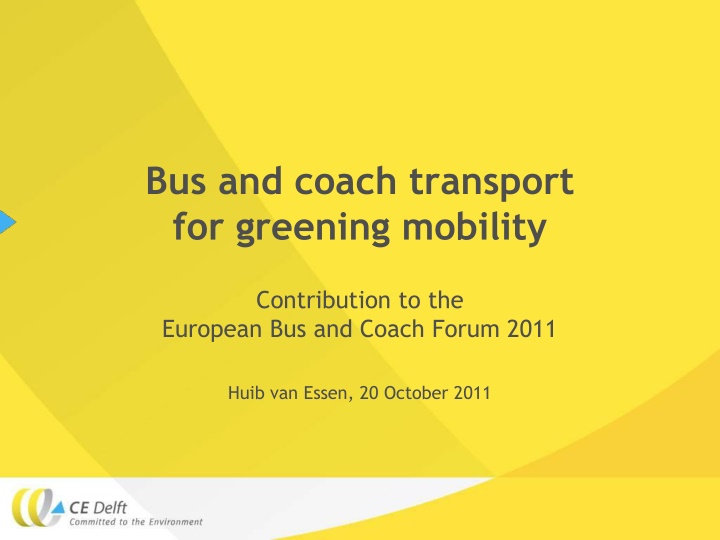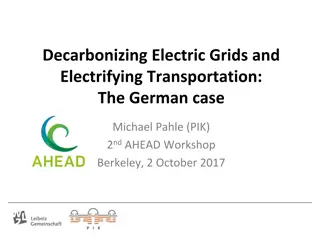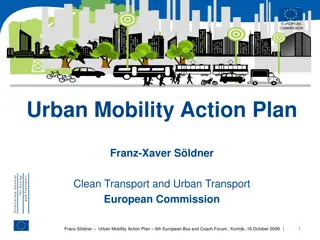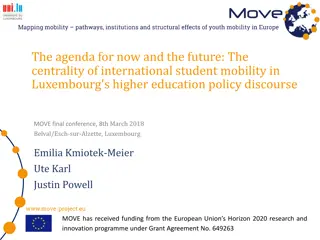Greening Mobility: Decarbonizing Transport and Future Trends
Decarbonizing transport is a significant challenge that necessitates low-carbon technologies and strategies to reduce CO2 emissions. Comparing environmental performance of transport modes reveals the importance of factors such as occupancy rates and fuel efficiency. Coaches emerge as a strong contender with potential for reduced emissions through various strategies, alongside advancements in Euro standards and the decarbonization of electricity. The future trends in greening mobility focus on improving occupancy rates, fuel efficiency, and exploring low-carbon energy options.
Download Presentation

Please find below an Image/Link to download the presentation.
The content on the website is provided AS IS for your information and personal use only. It may not be sold, licensed, or shared on other websites without obtaining consent from the author.If you encounter any issues during the download, it is possible that the publisher has removed the file from their server.
You are allowed to download the files provided on this website for personal or commercial use, subject to the condition that they are used lawfully. All files are the property of their respective owners.
The content on the website is provided AS IS for your information and personal use only. It may not be sold, licensed, or shared on other websites without obtaining consent from the author.
E N D
Presentation Transcript
Bus and coach transport for greening mobility Contribution to the European Bus and Coach Forum 2011 Huib van Essen, 20 October 2011
The great challenge of decarbonizing transport requires low-carbon technology and decoupling 120% EU-27 CO2 emissions (1990 = 100%) 100% Total CO2emissions 80% 60% 40% 20% CO2emissions of transport 0% 1990 2000 2010 2020 2030 2040 2050 Huib van Essen, 20 October 2011 2
Environmental performance of transport modes: how to compare? Types of impacts: Emissions: CO2(climate change), NOx, PM (air quality) Other environmental impacts: noise, upstream emissions Other socio-economic impacts: accidents and congestion Fair comparisons require: Well-to-wheel approach Real life emission factors Door-to-door Detour factors Realistic occupancy rates and empty driving Huib van Essen, 20 October 2011 3
GHG emissions - short distance transport CO2 (g/pass-km); short range; day average; 2010 Average util. 1 pass. 2 pass. 3 pass. 4 pass. 250 200 150 100 50 0 Tram Metro Moped City bus Motorcycle Car (LPG) Car (petrol) Regional bus Car (diesel) Reg. train (elec.) IC train (elec.) Reg. train (diesel) Huib van Essen, 20 October 2011 4
GHG emissions - long distance transport CO2 (g/pass-km); long range; 2010 Average util. 1 pass. 2 pass. 3 pass. 4 pass. CO2-eq 450 400 350 300 250 200 150 100 50 0 Coach Car (LPG) Car (petrol) Car (diesel) High speed train Aircraft (463 km) IC train (electric) Aircraft (1389 km) Aircraft (2778 km) Huib van Essen, 20 October 2011 5
Comparison of modes and future trends Occupancy rates decisive CO2reduction for bus & coach: Short term limited, but coaches still among best-in-class Longer term options: fuel efficiency, low carbon energy, logistics Air pollutant emission relatively high; will improve with Euro-VI Competing modes improve their emission performance: Euro standards CO2standards for cars Decarbonization of electricity Bestand:Van Hool waterstofbus.jpg Huib van Essen, 20 October 2011 6
White Paper on Transport 2011: objectives 60% GHG reduction in 2050 compared to 1990 (overall: 80-95%) No conventional cars in urban areas in 2050; -/-50% in 2030 Passenger transport over medium distance (<1000 km) mainly by rail 40% sustainable low-carbon fuels for aviation in 2050 Road accident fatalities to zero in 2050 Full application of user/polluter pays principles (internalisation of external costs) Huib van Essen, 20 October 2011 7
White Paper on Transport 2011: assessment Modal shift is a target but not significant in impact assessment Decoupling transport growth from GDP: not a target but assumed in impact assessment Not much attention for bus and coach No clear vision on their contribution to long-term objectives (in contrast to rail transport) Transport CO2 Emissions - Decomposition 2% decarbonisation reference 300 GDP 1% 250 average annual percent change Index (1990=100) 0% 200 Freight transport -1% 150 Passenger transport -2% 100 -3% CO2 emissions Activity Modal Share Energy Efficiency Fuel Choice Population 50 -4% 0 1990 -5% 2010 2030 2050 -6% 2010>2030 2030>2050 2010>2030 2030>2050 Huib van Essen, 20 October 2011 8
Potential of bus and coach transport for greening transport Bus and particularly coach transport have important advantages: Flexible modes of transport; door-to-door Low external and infrastructure costs (2 to 4 times lower than cars per passenger) Main challenges: Many practical improvements, e.g. infrastructure, ticketing, marketing, ICT, service levels, etc. Increase of load factors (particularly for public transport buses) Further decarbonization required to stay among best-in-class Not much attention from policy makers: no long-term vision Huib van Essen, 20 October 2011 9
Elements of a policy framework Generic instruments: Harmonized fuel and carbon taxes, ETS, road pricing Stimulation of bus and coach transport: Infrastructure such as bus/coach lanes, P+R, terminals Opening of intercity coach markets Improving regulation regarding driving times and rest periods Harmonization of VAT rates across all modes Promotion of collective transport modes Policy instruments aimed at passenger cars: Parking policies, congestion pricing and taxation Harmonization of speed policy (e.g. motorway speeds of 90-100 km/h) Car-free and environmental zones Policies for improving the environmental performance of bus and coach Huib van Essen, 20 October 2011 10
Main conclusions and recommendations Coach: Lowest CO2emissions of all long distance modes (with E-trains) Competitive pollutant emissions Public transport buses: CO2emissions lower than cars Relatively high pollutant emissions Further decarbonization and emission reductions needed Bus and coach have potential to contribute to White Paper targets No clear vision on collective bus and coach transport in White Paper Development of a clear ambitious realistic vision on the role of bus and coach in the future of transport Europe needed Huib van Essen, 20 October 2011 11
Questions? Huib van Essen, 20 October 2011 12
Pollutant (NOx) emissions - short distance NOx (g/pass-km); short range; day average; 2010 Average util. 1 pass. 2 pass. 3 pass. 4 pass. 1,4 1,2 1,0 0,8 0,6 0,4 0,2 0,0 Tram Metro Moped City bus Motorcycle Car (LPG) Car (petrol) Regional bus Car (diesel) Reg. train (elec.) IC train (elec.) Reg. train (diesel) Huib van Essen, 20 October 2011 13
Pollutant (NOx) emissions - long distance NOx (g/pass-km); long range; 2010 Average util. 1 pass. 2 pass. 3 pass. 4 pass. LTO 0,9 0,8 0,7 0,6 0,5 0,4 0,3 0,2 0,1 0,0 Coach Car (LPG) Car (petrol) Car (diesel) High speed train IC train (elec.) Aircraft (463 km) Aircraft (1389 km) Aircraft (2778 km) Huib van Essen, 20 October 2011 14
Options for decarbonizing buses and coaches Improving energy efficiency of conventional vehicles: Engine and transmission, including hybridization (city buses) Aerodynamics and Rolling resistance of tyres Eco-driving Shift to alternative energy carriers: Gas (LNG, CNG, Bio-gas) Bio-fuels Electricity Hydrogen Bestand:Van Hool waterstofbus.jpg Logistic optimizations (higher occupancy rates) Huib van Essen, 20 October 2011 15























